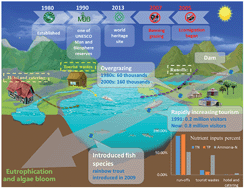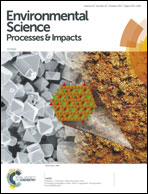Response of the phytoplankton community to water quality in a local alpine glacial lake of Xinjiang Tianchi, China: potential drivers and management implications†
Abstract
Eutrophication has become one of the most serious threats to aquatic ecosystems in the world. With the combined drivers of climate change and human activities, eutrophication has expanded from warm shallow lakes to cold-water lakes in relatively high latitude regions and has raised greater concerns over lake aquatic ecosystem health. A two-year field study was carried out to investigate water quality, phytoplankton characteristics and eutrophication status in a typical alpine glacial lake of Tianchi, a scenic area and an important drinking water source in the Xinjiang Autonomous Region of China, in 2014 and 2015. Clear seasonal and annual variations of nutrients and organic pollutants were found especially during rainy seasons. For the phytoplankton community, Bacillariophyta held the dominant position in terms of both species and biomass throughout the year, suggesting the dominant characteristics of diatoms in the phytoplankton structure in such a high-altitude cold-water lake. This was quite different from plain and warm lakes troubled with cyanobacterial blooming. Moreover, the dominant abundance of Cyclotella sp. in Tianchi might suggest regional warming caused by climate change, which might have profound effects on the local ecosystems and hydrological cycle. Based on water quality parameters, a comprehensive trophic level index TLI (Σ) was calculated to estimate the current status of eutrophication, and the results inferred emerging eutrophication in Tianchi. Results from Canonical Correspondence Analysis (CCA) and correlation analysis of phytoplankton genera and physico-chemical variables of water indicated that abiotic factors significantly influenced the phytoplankton community and its succession in Tianchi Lake. These abiotic factors could explain 77.82% of the total variance, and ammonium was identified as the most discriminant variable, which could explain 41% of the total variance followed by TP (29%). An estimation of annual nutrient loadings to Tianchi was made, and the results indicated that about 212.97 t of total nitrogen and 32.14 t of total phosphorus were transported into Tianchi Lake annually. Human socio-economic activities (runoff caused by historical overgrazing and increasing tourism) were identified as the most important contributors to Tianchi nutrient loadings.



 Please wait while we load your content...
Please wait while we load your content...